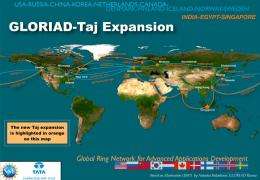Topographical map shows GLORIAD's fiberoptic ring of rings structure: current and future connectivity. GLORIAD is a modern communications cyberinfrastructure constructed from a fiberoptic ring around the northern hemisphere. It connects universities, research institutes and national laboratories across the globe for science and research applications. The map describes GLORIAD network topology and the ring of rings structure. Current links are shown in blue and the proposed Taj expansion links are shown in orange. Credit: GLORIAD.
(PhysOrg.com) -- The National Science Foundation (NSF)-funded Taj network has expanded to the Global Ring Network for Advanced Application Development (GLORIAD), wrapping another ring of light around the northern hemisphere for science and education. Taj now connects India, Singapore, Vietnam and Egypt to the GLORIAD global infrastructure and dramatically improves existing U.S. network links with China and the Nordic region.
Taj promises far-reaching, stimulative and sustainable benefits in global research and education (R&E) collaboration. It will serve every knowledge disciplines from high energy physics, atmospheric and climate change science, to renewable energy research, to nuclear nonproliferation, genomics and medicine, economics and history. The population of countries served by the NSF-sponsored GLORIAD program, funded since 1997, now exceeds half the globe.
In a unique public/private partnership with NSF, Tata Communications is providing a new billion bits per second (Gbps) service connecting science and education exchange points in Hong Kong, Singapore, Alexandria, Mumbai, Amsterdam and Copenhagen (valued at $6 million) to interconnect vital national research and education networks in India and across Southeast Asia, including Singapore and Vietnam.
The new exchange point in Alexandria, Egypt affords new possibilities for science and education ties throughout the Middle East, Africa and Central Asia and the Caucasus regions. Taj opens up new horizons for U.S. scientists, educators and students, enabling direct access to key research facilities in India, and, through new exchange points in Egypt and Singapore, improved connectivity for potentially millions of end-users conducting international collaborative research.
"The possibilities are exciting," said NSF Director Arden L. Bement, Jr. "GLORIAD provides advanced tools for active collaboration on common problems, spanning climate change, cybersecurity, early warning systems, global public health, and renewable and alternative energy."
"Science is increasingly data-driven and collaborative, and does not respect national borders. High speed optical networks are critical to both national and international scientific efforts," added Ed Seidel, acting assistant director of NSF's Math and the Physical Sciences Directorate on leave from his post as director of NSF's Office of Cyberinfrastructure. "The NSF and its partners are excited to support the development of the Taj network and expect the scientific payoffs to be tremendous."
"This network promises a new model of international cooperation, makes easy sharing global network management tasks, and focuses on user-leave performance," NSF Office of International Science and Engineering Program Director Bill Chang continued.
The Taj expansion also dramatically enhances GLORIAD's existing research and education network exchange and peering services. The project upgrades existing US-China network service by a factor of 4--from 2.5 Gbps to 10 Gbps, placing high capacity network applications on dedicated lightpaths and carefully managed Layer-3 network services.
The GLORIAD network "Infrastructure" connects users at very high speed, 10 Gbps. The network is open to all non-commercial use across political boundaries. Monitoring data flow ensures mutual "Cybersecurity." Applications and databases from disparate sources can interact across the network through the help of "Grid Middleware." The system enables "Global Collaboration:" researchers, the end users, may share data, instrumentation and processing power. Credit: Zina Deretsky, NSF
"Taj represents a next big step in the evolution of this global network GLORIAD," said Taj principal investigator Greg Cole, "By welcoming new partners in Singapore, India, Egypt and Vietnam, and by strengthening existing partnerships with China, five Nordic countries, and our global corporate partner, Tata Communications, Taj dramatically expands the world's science communities by linking scientists, educators and students with the most advanced services available today."
In partnership with NORDUNet, Taj's "IceLink" brings two 10 Gbps high capacity circuits to the northern polar region, connecting the U.S. to Greenland, the five Nordic countries and Russia. Climate change and polar researchers now will be able to efficiently transfer data using today's most advanced cyberinfrastructure.
It will enable global open science collaboration in an era of constrained resources via carefully organized collaboration and co-funding with public and private sectors in Europe and Asia. The Taj program is new, yet it efficiently builds on the GLORIAD network infrastructure, which today connects U.S., China, and Russia--as well as Korea, Canada, Netherlands and the five Nordic countries.
"CSTNet is a founding member of GLORIAD. We are delighted to be a partner in the Taj connection, it will strengthen the scientific cooperation with the U.S. and Nordic countries and with many nations in South Asia and North Africa, " said LI Jun, director of CAS CSTNet.
The project also continues to create pioneering measurement and data visualization tools, creates a new decentralized method of distributing network operations around the globe and introduces a new program for education, outreach and training called "CyberspaceBook."
"NORDUnet is continuously striving to facilitate connectivity and collaboration between Nordic and global researchers and students working together with our partners worldwide. The (GLORIAD) IceLink connection is a shining example of what can be achieved when international partners join forces to bridge a connectivity gap until now difficult to reach." says Rene Buch, CEO of NORDUNet. "This project will enable scientists to expand the research into the Arctic region within climate, seismic and oceanographic sciences. In addition the (GLORIAD) IceLink will provide access to CO2 neutral energy source ideal for powering large scale computing installation needed for Scientific modelling and computation."
Networks that are connected to GLORIAD exchange points will gain direct access to the new networks and services as soon as they are implemented. Other networks, institutions and researchers that wish to connect to the Taj or GLORIAD networks are encouraged to contact GLORIAD.
Provided by NSF



















